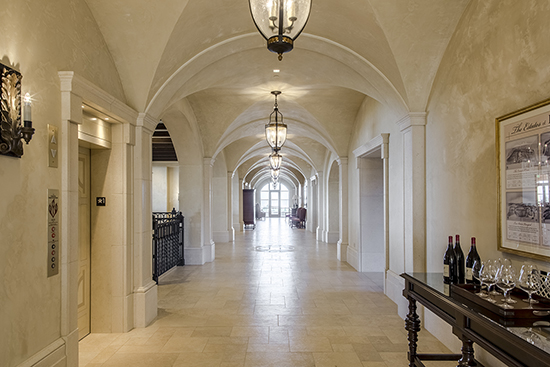|
Subscribe / Renew |
|
|
Contact Us |
|
| ► Subscribe to our Free Weekly Newsletter | |
| home | Welcome, sign in or click here to subscribe. | login |
Construction
| |
 |
May 4, 2018
Interior Commercial • Oregon

Domaine Serene
Location: Dayton
Contractor: Billings & Cronn Co.
Architect: Waterleaf Architecture
Team: BASF Senergy, BMI Products, Evergreen Building Products, GTS Interior Supply, Knez Building Materials Co., Spears Construction Supply, Steeler, USG Building Systems, Western Materials
Domaine Serene, an established winery nestled in the Dundee Hills of Oregon’s Willamette Valley, opened a new visitor center and tasting room last year called The Clubhouse. The owners’ vision for The Clubhouse was inspired by Chateau de la Cree, their 15th-century estate in the Burgundy region of France.
This project was a unique opportunity to combine old-world craftsmanship and detailing with modern building materials and techniques. The 34,000-square-foot Clubhouse includes a vaulted public wine-tasting room, exclusive wine club member areas, an underground cave with wine storage, catering kitchens and administrative offices.
Meeting current standards for seismic codes, fire sprinklers, fire alarms, speakers and HVAC was a complex process. It took the Schommer & Sons construction team five sample boards to find the right stone to meet seismic demands. Meanwhile, Waterleaf Architecture was working with design-build craftsmen who built trapezoidal ductwork to fit in the arches, concealed sprinkler heads, hidden speakers and old iron gates equipped with ventilation air grilles.
Another challenge was the half-mile of plasterwork needed. Plaster is an old-world technology that has become nearly obsolete. Schommer & Sons worked with contractor Billings & Cronn Co. to convince retired craftsmen to train the next generation of plasterers. Instead of wood frames, they used laser-cut profiles to make the plaster frieze.
The site is an active winery surrounded by prized vineyards. Because of this, the project sought to minimize environmental impacts by using an old logging road to protect the existing approach from damage, preventing dust and stormwater pollution, relocating native white oak trees during construction, and carefully integrating parking and walkways.
The Clubhouse was designed to last for generations, and is truly a destination for those who enjoy fine craftsmanship.
Judge’s comment: “The plasterers’ artistry is incredible. This classic building technique is too rarely used in today’s construction, which is a real loss. Achievements like this plasterwork deserve to be celebrated. Just wow.”
Other Stories:
- 5 ways to make the most of your revenue
- Light-Gage Steel Framing • Oregon
- Suspended Ceiling • Oregon
- Renovation/Restoration • Oregon
- Exterior Residential • Oregon
- Exterior Commercial • Oregon
- Interior Residential • Washington
- Exterior Residential • Washington
- Suspended Ceiling • Washington
- Light-Gauge Steel Framing • Washington
- Exterior Commercial • Washington
- Renovation/Restoration • Washington
- Renovation/Restoration • Washington
- Interior Residential • Oregon


